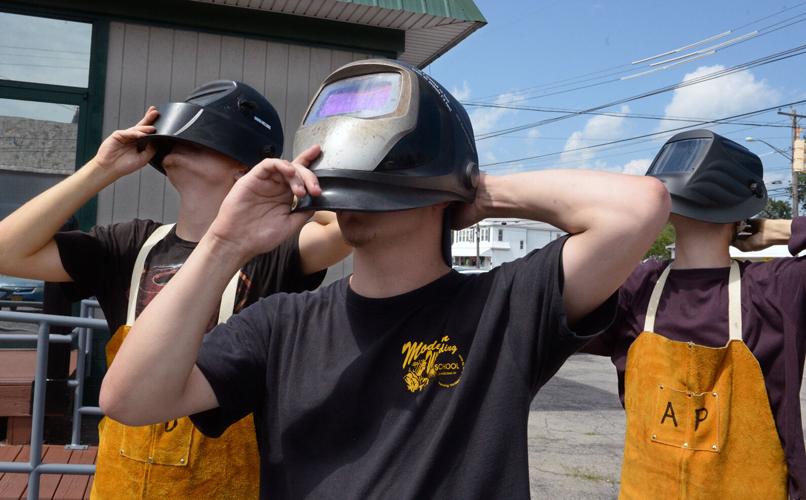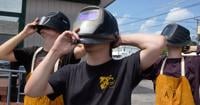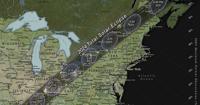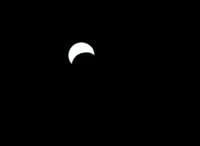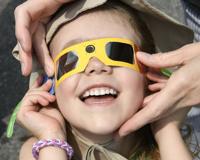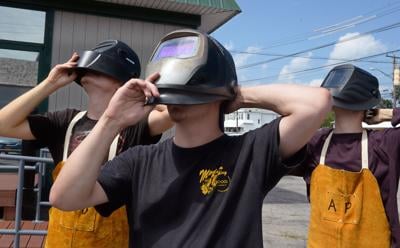ALBANY - The great solar eclipse of 2024 is set for April and most of New York State will get a show.
Exactly how cool a show you'll get? Well that will depend on where you are - and whether you'll see "totality."
Here in the Capital Region, we'll see the partial variety - more than 97 percent coverage.
But, experts say, if you're a fan of celestial events, the best show - totality - won't be here, it will be to the north and west.
"Officially, it's going to be about a 3-4% difference," Melanie Evans, executive director of the Dudley Observatory at Siena College, said in an email. "However, that 3-4% makes a big difference when you're talking about the concentrated power of sunlight."
Full totality - the moon completely covering the sun - brings with it a bunch of other benefits, including daytime darkness and seeing the sun's corona effect.
"The whole atmosphere will be like dusk has suddenly hit with associated changes (inset noise, air temperature drop, etc.)," Evans wrote.

Eclipse 2024 path from NASA, focused on the Northeast
So where will totality be?
From the Capital Region, sky gazers only will have to go north or west - wherever has the best chance of clear skies.
The full solar eclipse will be seen in a swath extending across western and northern New York, from Buffalo to Rochester to Plattsburgh.
According to TimeandDate.com, Plattsburgh will see a full 3 minutes and 34 seconds of "totality," Fort Drum 3 minutes and 39 seconds, Rochester 3 minutes, 39 seconds and Buffalo at 3 minutes and 46 seconds.
OK, so when is the eclipse?
The eclipse is April 8 and the sun will start to be obscured just after 2 p.m. and be back to full strength after 4:30 p.m.
How much eclipse will we see in the Capital Region?
A good amount, but still not enough. The peak will come at 3:26 p.m. The peak percentages for cities around the Capital Region, according to TimeandDate.com:
In the Capital Region, the maximum will be hit at 3:26 p.m. across the area. Schenectady is to see 97.3 percent coverage, Gloversville 98.4 percent and Glens Falls 98.5 percent, according to TimeandDate.com.
Amsterdam will see 97.9 percent, Saratoga Springs 97.9 percent, too.

Charlie Stevens, 4, of Rotterdam, looks at the sun with eclipse glasses provided by miSci at the Kids Art Festival near City Hall Saturday, June 1, 2019.
Are there events tied to the April solar eclipse?
Plenty already. In the cities that will see totality, there is plenty being planned. Elsewhere, too.
In Buffalo, Knox Farm State Park is hosting an afternoon-long event on the day, including educational activities and music. Tickets are $15.
BuffaloNiagara.com has more on events in the Buffalo area.
In Rochester, a whole three-day festival is planned, Roc the Eclipse 2024, April 6, 7 and 8, including exhibitors, solar telescope viewing and stage entertainment. More at the Rochester Museum & Science Center, RMSC.org.
In Plattsburgh, SUNY Plattsburgh is offering festivities for those who want to enjoy the event there.
"Because Plattsburgh will be in the center of the total solar eclipse, we will also see the sun’s corona, the outer atmosphere, which is otherwise usually obscured by the bright face of the sun," SUNY Plattsburgh's eclipse site reads. "This will be a very rare and special experience and we hope you will plan to participate with us!"

2017 Solar Eclipse on Monday, August 21, 2017, as seen through a filter
What eclipse events will be offered in the Capital Region?
Among those holding local events will be Siena College's Dudley Observatory. The Dudley team will be hosting demonstrations for safe viewing methods and discussing the science behind the eclipse from 1 to 5 p.m. April 8.
At MiSci in Schenectady, they'll be holding special programs, training and classes. Classes and workshops will be held Feb. 28, March 16 and March 20. For more information on times and cost visit MiSci.org/eclipse
Schools are set to get in on the watch parties, too. The Scotia-Glenville schools science department is having an eclipse watch party for students after school, with a registration deadline for transportation Jan. 31.
What about schools?
Many schools are approaching the day as a day off, or at an early release day.
Dozens of greater Capital Region schools could close as districts cite safety concerns and spring break for closing.
How about recommended viewing procedures?
The state DEC actually offers guidance on this. Eyes must be protected. Special filters are required for cameras, binoculars or telescopes as without the filters, eyes can be instantly severely injured. Certified eclipse glasses from a trusted source work. Regular sunglasses, polarized or otherwise, don't.
The DEC recommends allowing for plenty of travel time and bring needed water, fuel and medications. State land rules remain in effect.
Didn't we just see a solar eclipse in the Capital Region?
Yes, but not like this. On Aug. 21, 2017, another big solar eclipse was visible locally, but only partial and we weren't at all near totality. Schenectady saw a maximum of 72.3 percent coverage in that one.
What about the next solar eclipse? When's that?
Well, not for a while. The region is set to see another, lesser eclipse Nov. 4, 2040, where Schenectady will see 68 percent coverage, June 11, 2048, 81.3 percent coverage, and March 30, 2052, 75.4 percent coverage.
Then, for those who want to wait, Schenectady is to just miss totality in a solar eclipse the morning of May 1, 2079, 55 years from now, at 99.9 percent, according to TimeandDate.com.
For the 2079 eclipse, though, you'll just have to drive, or whatever we'll be doing then, over to Albany for totality of 42 seconds.








